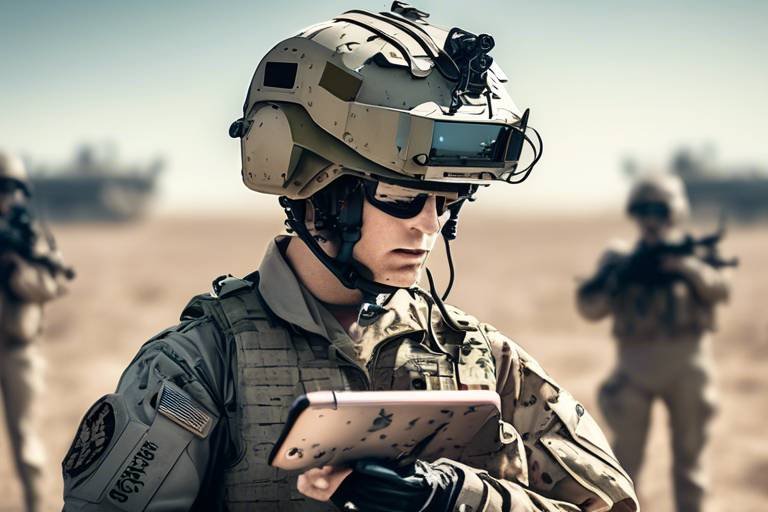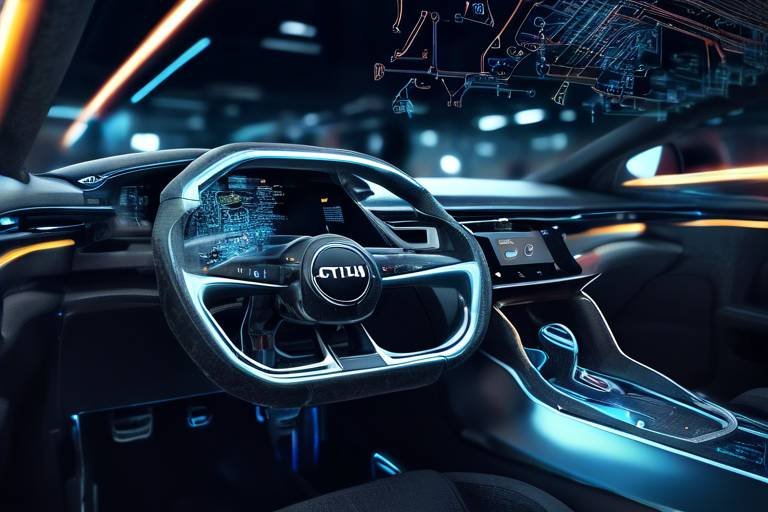Military Applications of AI: Latest Trends
In recent years, the integration of artificial intelligence (AI) into military applications has taken a transformative leap, reshaping how armed forces operate on a global scale. From enhancing strategic planning to revolutionizing combat tactics, AI is becoming an indispensable tool in modern warfare. The military sector is increasingly leveraging AI to not only boost efficiency but also to gain a tactical edge over adversaries. This article delves into the latest trends in military AI applications, highlighting their impact on strategy, operations, and technology within defense sectors worldwide.
Artificial intelligence is revolutionizing military strategy by enabling data-driven decision-making, enhancing predictive analytics, and optimizing resource allocation for improved operational effectiveness. Imagine a battlefield where commanders can analyze vast amounts of data in real-time, making informed decisions faster than ever before. With AI, military leaders can evaluate numerous scenarios, predict enemy movements, and allocate resources more efficiently, ultimately leading to better outcomes in critical situations.
The development of autonomous weapons systems raises ethical and operational questions, as AI-driven platforms increasingly take on combat roles. These systems can operate independently, making decisions without human intervention. This shift necessitates discussions on accountability and control, as the implications of allowing machines to make life-and-death decisions are profound. How do we ensure that these systems adhere to the rules of engagement? Who is responsible for their actions in the heat of battle? These are questions that military strategists and ethicists must grapple with as technology evolves.
AI-powered drones are transforming reconnaissance and combat missions, providing real-time intelligence and precision strikes while minimizing risks to human operators on the battlefield. These drones can autonomously navigate complex environments, gather critical data, and engage targets with pinpoint accuracy. The ability to deploy drones equipped with AI not only enhances operational effectiveness but also reduces the risk to personnel, allowing for safer mission execution. The integration of AI into drone technology represents a significant leap forward in military capabilities.
Swarm robotics, utilizing AI algorithms, enables coordinated operations among multiple drones or ground units. This technology enhances tactical advantages through collective intelligence and adaptability in dynamic environments. Imagine a swarm of drones working together seamlessly, communicating in real-time to outmaneuver an enemy force. This level of coordination can overwhelm traditional defenses and provide a significant edge in combat scenarios.
AI-driven counter-drone technologies are essential for detecting and neutralizing threats posed by enemy drones. As the use of drones in warfare becomes more prevalent, safeguarding military installations and personnel from aerial attacks is crucial. These counter-drone systems leverage AI to identify hostile drones, predict their flight paths, and deploy countermeasures effectively. This proactive approach to drone warfare is vital for maintaining operational security and protecting assets.
AI applications in logistics streamline supply chain management, improving inventory tracking, predictive maintenance, and resource allocation. In military operations, efficient logistics can mean the difference between success and failure. AI enables military organizations to anticipate supply needs, optimize transportation routes, and ensure that resources are available when and where they are needed most. This level of efficiency not only enhances operational readiness but also reduces costs and waste.
AI plays a critical role in bolstering military cybersecurity by detecting anomalies, predicting threats, and automating responses to potential cyberattacks on defense networks. In an age where cyber warfare is a growing concern, the ability to safeguard sensitive information and infrastructure is paramount. AI enhances the military's ability to stay one step ahead of cyber adversaries, ensuring the integrity of vital systems.
Advanced AI algorithms enhance threat detection capabilities by identifying potential vulnerabilities and malicious activities in real-time. This proactive approach strengthens the overall security posture of military systems, allowing for rapid response to emerging threats. By continuously monitoring networks and analyzing patterns, AI can flag unusual activities before they escalate into serious breaches.
AI-driven automation in incident response enables rapid mitigation of cyber threats. This allows military organizations to respond effectively and minimize damage during attacks. With automated systems in place, the military can quickly identify, isolate, and neutralize threats, preserving the integrity of critical operations and data.
AI technologies enhance military training and simulation programs, providing realistic scenarios and adaptive learning environments. These advancements prepare personnel for various operational challenges, ensuring they are well-equipped to handle the complexities of modern warfare. The ability to simulate real-world conditions allows soldiers to practice tactics and decision-making in a safe environment, ultimately leading to better preparedness.
Integrating AI with virtual reality creates immersive training experiences. Soldiers can practice tactics and decision-making in simulated environments that closely mirror real-world conditions. This technology not only makes training more engaging but also enhances skill retention and application in actual combat situations.
AI-powered personalized learning systems tailor training programs to individual soldiers' needs. By analyzing performance data, these systems optimize skill acquisition and ensure readiness for diverse mission requirements. Just like a personal coach, AI can identify strengths and weaknesses, allowing for targeted training that maximizes each soldier's potential.
- What are the primary benefits of AI in military applications? AI enhances decision-making, improves operational efficiency, and provides advanced threat detection capabilities.
- Are there ethical concerns surrounding autonomous weapons? Yes, the use of autonomous weapons raises significant ethical questions about accountability and the potential for misuse.
- How does AI improve military training? AI creates realistic training environments and personalized learning experiences, enhancing soldier preparedness.

AI in Defense Strategy
Artificial intelligence is revolutionizing military strategy by enabling data-driven decision-making, enhancing predictive analytics, and optimizing resource allocation for improved operational effectiveness. Imagine a battlefield where decisions are made not just based on intuition but on vast amounts of data processed in real-time. This is the new reality with AI, which allows military leaders to analyze patterns, predict outcomes, and make informed choices that can mean the difference between victory and defeat.
One of the most significant advantages of AI in defense strategy is its ability to process and analyze data at unprecedented speeds. Traditional methods of intelligence gathering can be slow and cumbersome, often resulting in outdated information by the time it reaches decision-makers. In contrast, AI systems can sift through mountains of data—be it satellite imagery, social media feeds, or sensor outputs—within seconds. This capability not only enhances situational awareness but also allows for proactive strategies rather than reactive ones.
Furthermore, AI is enhancing military logistics and resource allocation. By analyzing historical data and current operational needs, AI can optimize supply chains, ensuring that troops have the right resources at the right time. For instance, AI can predict when equipment will require maintenance, thereby preventing unexpected failures and ensuring that military operations run smoothly. This level of efficiency is akin to having a personal assistant who not only remembers your schedule but also anticipates your needs before you even realize them.
However, the integration of AI into military strategy is not without its challenges. As we embrace these cutting-edge technologies, we must also consider the ethical implications. Questions surrounding accountability arise: who is responsible when an AI-driven decision leads to unintended consequences? Can we trust algorithms to make life-and-death decisions? These are critical discussions that need to take place as we move forward.
In summary, AI is not just a tool but a transformative force in military strategy. It empowers leaders with data-driven insights, enhances operational efficiency, and introduces new paradigms of warfare. As we continue to explore the capabilities of AI, we must remain vigilant about the ethical considerations that accompany such powerful technologies. The future of military strategy is here, and it is powered by artificial intelligence.
- What role does AI play in military decision-making? AI enhances military decision-making by providing real-time data analysis, improving situational awareness, and enabling proactive strategies.
- How does AI improve logistics in the military? AI optimizes supply chains and resource allocation by predicting maintenance needs and ensuring timely delivery of resources.
- What are the ethical implications of using AI in defense? The use of AI in defense raises questions about accountability and trust, particularly regarding life-and-death decisions made by algorithms.

Autonomous Weapons Systems
The rise of marks a significant shift in the landscape of modern warfare. These systems, which operate with minimal human intervention, are designed to execute combat tasks based on pre-programmed algorithms and real-time data analysis. While they promise enhanced efficiency and effectiveness on the battlefield, they also bring forth a plethora of ethical and operational dilemmas that demand urgent attention.
One of the most pressing concerns surrounding autonomous weapons is the question of accountability. When an AI-driven platform makes a decision that results in collateral damage, who is responsible? Is it the programmer, the military commander, or the machine itself? This ambiguity raises serious moral questions about the extent to which we should delegate life-and-death decisions to machines. Moreover, the potential for malfunction or miscalculation in high-stakes scenarios can lead to catastrophic consequences, amplifying the need for stringent oversight and regulation.
In addition to accountability, there are operational challenges that come with integrating autonomous systems into military frameworks. For instance, the ability of these systems to operate in unpredictable environments is still under scrutiny. While AI can analyze vast amounts of data and adapt to certain conditions, the complexity of human behavior and the chaos of warfare present challenges that AI may not yet be equipped to handle. Therefore, it is essential to strike a balance between leveraging technology and maintaining human oversight in critical operations.
Autonomous weapons systems are being developed and deployed in various forms, each with unique capabilities and applications. Some notable examples include:
- Unmanned Aerial Vehicles (UAVs): Drones equipped with AI can conduct surveillance and targeted strikes with precision, reducing risks to human operators.
- Autonomous Ground Vehicles: These vehicles can navigate complex terrains and engage in combat scenarios without direct human control.
- Missile Systems: AI-driven missiles can adapt their trajectories and targets based on real-time intelligence, improving strike accuracy.
As military organizations around the world invest in these technologies, the implications for global security and warfare are profound. The potential for autonomous weapons to change the nature of conflict is immense, but it also raises the specter of an arms race in AI-driven warfare. Nations may feel compelled to develop their own autonomous systems to keep pace with adversaries, leading to a destabilizing cycle of escalation.
With the rapid advancement of autonomous weapons systems, ethical considerations must be at the forefront of discussions. The United Nations and various advocacy groups have called for a ban on fully autonomous weapons, arguing that machines should not have the authority to make life-and-death decisions. The debate continues, with voices on both sides presenting compelling arguments.
As we stand on the brink of a new era in military technology, we must ask ourselves: Are we ready to embrace the future of warfare with autonomous systems, or should we tread cautiously? The conversation surrounding these weapons is not just about technology; it’s about our values, our humanity, and the kind of world we want to create.
Q1: What are autonomous weapons systems?
Autonomous weapons systems are military technologies that can operate and make decisions without direct human control, utilizing artificial intelligence to analyze data and execute tasks.
Q2: What are the ethical concerns associated with autonomous weapons?
The primary ethical concerns include accountability for actions taken by these systems, the potential for malfunction, and the moral implications of machines making life-and-death decisions.
Q3: How are autonomous weapons currently being used?
They are being deployed in various forms, including drones for surveillance and strikes, autonomous ground vehicles for combat, and advanced missile systems that can adapt to real-time data.
Q4: Is there a global consensus on the regulation of autonomous weapons?
There is currently no global consensus, but discussions are ongoing at international forums, including the United Nations, regarding the need for regulations or bans on fully autonomous weapons.

Drone Technology
In recent years, AI-powered drones have emerged as a game-changer in military operations, fundamentally altering how reconnaissance and combat missions are conducted. These advanced aerial vehicles, equipped with sophisticated artificial intelligence, are not just flying machines; they represent a leap forward in military strategy and execution. Imagine having the ability to gather real-time intelligence from the sky, pinpoint enemy locations, and execute precision strikes—all while keeping human operators safely out of harm's way. This is the reality that AI-driven drones are creating on the modern battlefield.
One of the most significant advantages of drone technology is its ability to conduct surveillance and reconnaissance missions with unparalleled efficiency. Traditional methods often involve manned aircraft, which can be costly and risky. In contrast, drones can cover vast areas quickly, providing crucial information without endangering lives. For instance, a single AI-powered drone can monitor a designated zone, analyze movements, and relay critical data back to command centers in real time. This capability not only enhances situational awareness but also allows military planners to make informed decisions faster than ever.
Moreover, the precision of drone strikes has dramatically improved due to AI algorithms that assist in target identification and engagement. These drones can distinguish between combatants and non-combatants, significantly reducing the risk of collateral damage. The integration of machine learning enables drones to learn from past missions, continually improving their targeting accuracy. This evolution in technology raises important questions: How do we balance the effectiveness of these tools with the ethical implications of their use? As drones take on more combat roles, discussions around accountability and control become increasingly vital.
Additionally, the advent of swarm robotics is pushing the boundaries of what drone technology can achieve. By employing AI algorithms that enable multiple drones to operate in unison, military forces can execute complex maneuvers that were once thought impossible. Picture a fleet of drones working together, each one communicating and adapting to the battlefield environment in real time. This collective intelligence enhances tactical advantages, allowing for a more dynamic and responsive military strategy. Swarm robotics not only amplifies operational effectiveness but also complicates enemy defenses, making it harder for adversaries to counter such coordinated attacks.
However, with the rise of AI-powered drones comes the pressing need for counter-drone systems. As military organizations increasingly rely on these aerial assets, adversaries are developing technologies to neutralize them. AI-driven counter-drone solutions are essential for detecting and mitigating threats posed by enemy drones. These systems utilize advanced sensors and algorithms to identify hostile drones in the vicinity and deploy countermeasures, ensuring the safety of military personnel and installations from aerial attacks.
In conclusion, the integration of artificial intelligence into drone technology is revolutionizing military operations. From enhancing surveillance capabilities to executing precise strikes and coordinating complex maneuvers, AI-powered drones are reshaping the battlefield landscape. As we embrace these advancements, it is crucial to engage in ongoing discussions about the ethical implications and necessary safeguards to ensure that this powerful technology is used responsibly and effectively.
- What are AI-powered drones used for in the military? AI-powered drones are primarily used for reconnaissance, surveillance, and precision strikes, allowing for real-time intelligence gathering while minimizing risks to human operators.
- How do drones improve military strategy? Drones enhance military strategy by providing timely data, improving decision-making processes, and enabling more effective resource allocation on the battlefield.
- What are swarm robotics? Swarm robotics refers to the coordinated operation of multiple drones using AI algorithms, allowing them to work together to achieve complex tactical objectives.
- What are the ethical concerns surrounding drone warfare? The ethical concerns include accountability for strikes, potential civilian casualties, and the implications of using autonomous systems in combat scenarios.

Swarm Robotics
Swarm robotics is an exciting frontier in military technology, where multiple autonomous units work collaboratively to achieve complex objectives. Imagine a flock of birds or a school of fish moving in unison, each member responding to its neighbors while pursuing a common goal. This concept is at the heart of swarm robotics, where AI algorithms enable drones and ground units to communicate, coordinate, and adapt to dynamic battlefield conditions. The ability to operate as a cohesive unit offers significant tactical advantages, making it a game-changer in modern warfare.
At its core, swarm robotics leverages the principles of collective intelligence. By mimicking natural systems, military forces can deploy swarms of drones that execute missions with remarkable efficiency. For instance, when faced with a reconnaissance task, a swarm can cover a larger area in less time than a single drone, providing real-time intelligence that is crucial for decision-making. The adaptability of these robotic units also means they can quickly adjust their strategies in response to unforeseen challenges, much like a team of athletes adapting their plays during a game.
One of the most compelling aspects of swarm robotics is its potential for cost-effectiveness. Instead of relying on expensive, high-tech individual units, military forces can deploy numerous smaller, less expensive drones that work together. This not only reduces the overall cost of operations but also allows for greater resilience on the battlefield. If one unit is lost, the remaining units can still accomplish the mission, maintaining operational continuity.
However, the implementation of swarm robotics is not without its challenges. Issues of communication and control arise, particularly in ensuring that the swarm operates effectively without human intervention. Military strategists must grapple with the complexities of programming these units to make real-time decisions while ensuring accountability in their actions. Moreover, ethical questions regarding the use of autonomous systems in combat scenarios are increasingly coming to the forefront, necessitating a careful examination of the implications of deploying such technologies.
Despite these challenges, the future of swarm robotics in military applications looks promising. As technology continues to evolve, we can expect to see more sophisticated algorithms that enhance the capabilities of these robotic swarms. The integration of advanced sensors and AI will enable them to perform a wider range of tasks, from surveillance to direct engagement in combat scenarios. In essence, swarm robotics embodies the next evolution of military operations, where the power of many can be harnessed to achieve strategic objectives with unprecedented efficiency.
- What are swarm robotics? Swarm robotics refers to the use of multiple autonomous robots that work together to complete tasks, mimicking the behavior of natural swarms like flocks of birds or schools of fish.
- How do swarm robots communicate? Swarm robots use AI algorithms to share information with each other, allowing them to coordinate their actions and adapt to changing conditions on the battlefield.
- What are the benefits of swarm robotics in military applications? Benefits include cost-effectiveness, enhanced operational efficiency, greater resilience in missions, and the ability to cover larger areas for reconnaissance.
- What challenges do swarm robotics face? Challenges include communication and control issues, ethical considerations regarding autonomous decision-making, and the need for accountability in military operations.

Counter-Drone Systems
As the battlefield evolves, so too do the threats that military forces face. One of the most pressing challenges today is the proliferation of drones, which have become a vital tool for reconnaissance and combat. In response, have emerged as a crucial component of military strategy. These systems are designed to detect, track, and neutralize unauthorized or hostile drones, ensuring the safety of personnel and assets.
Counter-drone technologies utilize a combination of radar, radio frequency (RF) detection, and advanced algorithms to identify potential threats in real-time. Once a drone is detected, these systems can employ various countermeasures, including jamming signals, deploying nets, or even using directed energy weapons to disable the intruder. The versatility of these systems is essential in a landscape where drones can be used for both surveillance and offensive operations.
Moreover, the integration of artificial intelligence into counter-drone systems enhances their effectiveness significantly. AI algorithms can analyze vast amounts of data quickly, distinguishing between friendly and enemy drones, thus reducing the risk of friendly fire. This capability is particularly vital in complex operational environments where multiple drones may be present simultaneously. The ability to automate detection and response not only increases operational efficiency but also allows military personnel to focus on higher-level strategic tasks.
To give you a clearer picture of how these systems operate, consider the following table that outlines the key components and functionalities of modern counter-drone systems:
| Component | Functionality |
|---|---|
| Detection Systems | Identify and track drone activity using radar and RF technology. |
| Engagement Systems | Neutralize threats using methods such as jamming, nets, or kinetic projectiles. |
| Command & Control Software | Integrate data from various sources to make informed decisions rapidly. |
| AI Algorithms | Enhance threat identification and automate response protocols. |
As military forces continue to adapt to the challenges posed by drones, the importance of counter-drone systems cannot be overstated. They not only safeguard installations and personnel but also play a pivotal role in maintaining the integrity of operations. With advancements in AI and technology, these systems are set to become even more sophisticated, ensuring that military forces remain one step ahead of potential threats.
- What are counter-drone systems? Counter-drone systems are technologies designed to detect, track, and neutralize unauthorized or hostile drones.
- How do counter-drone systems work? They use a combination of radar, RF detection, and AI algorithms to identify threats and deploy countermeasures.
- What countermeasures do these systems employ? Common countermeasures include jamming signals, deploying nets, and using directed energy weapons.
- Why is AI important in counter-drone systems? AI enhances threat identification and automates responses, increasing the efficiency and safety of military operations.

Logistics and Supply Chain Optimization
In the fast-paced world of military operations, logistics and supply chain management are critical components that can make or break a mission. With the advent of artificial intelligence, these processes are undergoing a revolutionary transformation. Imagine a scenario where every supply route is optimized in real-time, where inventory levels are monitored automatically, and where predictive maintenance ensures that equipment is always mission-ready. This is not science fiction; it's the reality that AI is creating in military logistics.
AI applications are streamlining logistics by enhancing inventory tracking. Traditional methods often involve manual checks and time-consuming processes, which can lead to delays and inefficiencies. However, with AI, systems can automatically track supplies using advanced algorithms, ensuring that military units have the resources they need, exactly when they need them. This not only saves time but also reduces waste, as supplies are managed more effectively.
Moreover, the predictive capabilities of AI play a pivotal role in resource allocation. By analyzing historical data and current trends, AI can forecast future needs, enabling military planners to allocate resources more efficiently. For instance, if a particular unit is likely to require more ammunition based on previous engagements, AI can alert logistics teams to prepare and deliver additional supplies proactively. This proactive approach significantly enhances operational effectiveness.
Another fascinating aspect of AI in logistics is its role in predictive maintenance. Military equipment often operates under extreme conditions, which can lead to unexpected failures. AI systems can monitor the health of equipment in real-time, analyzing data from various sensors to predict when maintenance is required. This means that instead of waiting for a breakdown to occur, military forces can perform maintenance at optimal times, thereby increasing the lifespan of their equipment and ensuring that everything is ready for action.
To illustrate the impact of AI on logistics, consider the following table that highlights key benefits:
| AI Application | Benefit |
|---|---|
| Inventory Tracking | Real-time updates and reduced waste |
| Resource Allocation | Proactive supply management |
| Predictive Maintenance | Increased equipment reliability |
In conclusion, the integration of AI into military logistics is not just about keeping things running smoothly; it's about empowering military forces to be more agile and responsive. As AI continues to evolve, we can expect even greater enhancements in logistics and supply chain optimization, ultimately leading to more successful missions and improved safety for personnel on the ground.
- How does AI improve logistics in the military? AI enhances logistics through real-time inventory tracking, predictive maintenance, and efficient resource allocation.
- What are the benefits of predictive maintenance? Predictive maintenance helps prevent equipment failures by forecasting maintenance needs, thereby increasing reliability and reducing downtime.
- Can AI help in emergency situations? Yes, AI can analyze data quickly to optimize supply routes and ensure that necessary resources are delivered promptly during emergencies.

Cybersecurity Enhancements
In an era where digital threats evolve at lightning speed, artificial intelligence (AI) has emerged as a game-changer in military cybersecurity. The integration of AI into defense systems is not just a trend; it's a necessity. With the increasing sophistication of cyberattacks, military organizations are leveraging AI to bolster their defenses, ensuring that sensitive information remains secure and operational capabilities are not compromised. Imagine AI as a vigilant sentinel, tirelessly monitoring the vast digital landscape for any signs of intrusion or anomaly.
One of the most significant advantages of AI in cybersecurity is its ability to detect anomalies. Traditional security systems often rely on predefined rules to identify threats, which can leave them vulnerable to novel attacks. In contrast, AI algorithms are designed to learn from vast amounts of data, recognizing patterns and identifying deviations from the norm in real-time. This capability allows military cybersecurity teams to respond swiftly to potential threats, minimizing the risk of breaches that could jeopardize national security.
Moreover, AI plays a crucial role in predicting threats before they materialize. By analyzing historical data and current trends, AI systems can forecast potential attacks, providing military organizations with the foresight needed to fortify their defenses. This proactive approach is akin to having a crystal ball that reveals future vulnerabilities, enabling defense teams to take preemptive measures. For instance, an AI system might analyze traffic patterns on a military network and flag unusual spikes that could indicate a looming cyber threat.
In addition to threat detection and prediction, AI enhances incident response automation. When a cyberattack occurs, every second counts. AI-driven systems can automate responses to identified threats, executing predefined protocols that mitigate damage and secure systems. This rapid response capability is crucial in today's fast-paced cyber warfare environment, where human reaction times may not suffice. By automating incident response, military organizations can ensure that they are not only reacting to threats but also effectively neutralizing them before they escalate.
To illustrate the impact of AI in military cybersecurity, consider the following table that outlines various AI applications and their benefits:
| AI Application | Benefits |
|---|---|
| Anomaly Detection | Real-time identification of unusual activities in networks |
| Threat Prediction | Forecasting potential attacks based on data analysis |
| Incident Response Automation | Rapid execution of defense protocols during an attack |
| Vulnerability Assessment | Continuous evaluation of system weaknesses |
As military organizations continue to integrate AI into their cybersecurity frameworks, the importance of human oversight remains paramount. While AI can significantly enhance threat detection and response, it is essential to have skilled personnel who can interpret AI findings and make informed decisions. In this sense, AI should be viewed as a powerful ally, augmenting human capabilities rather than replacing them.
In conclusion, the enhancements brought about by AI in military cybersecurity are profound. By detecting anomalies, predicting threats, and automating responses, AI is transforming how military organizations protect their networks. As we move forward, the collaboration between AI technologies and human expertise will be critical in safeguarding national security against ever-evolving cyber threats.
- How does AI improve military cybersecurity? AI enhances military cybersecurity by enabling real-time anomaly detection, threat prediction, and automating incident responses.
- What are the main benefits of using AI in cybersecurity? The main benefits include faster threat detection, proactive risk management, and efficient incident response.
- Can AI completely replace human cybersecurity professionals? No, while AI can augment capabilities, human expertise is essential for interpreting data and making strategic decisions.

Threat Detection
In today's rapidly evolving digital landscape, has become a paramount concern for military organizations around the globe. With the advent of advanced AI algorithms, the ability to identify potential vulnerabilities and malicious activities in real-time has dramatically improved. Imagine having a vigilant sentinel that never sleeps—this is what AI brings to the table. By analyzing vast amounts of data at lightning speed, AI systems can pinpoint anomalies that human analysts might overlook.
One of the most significant advantages of AI in threat detection is its predictive capability. By leveraging historical data and machine learning, AI can forecast potential cyber threats before they materialize. This proactive approach is akin to having a weather forecast for cyberattacks; just as meteorologists predict storms, AI can foresee threats, allowing military networks to bolster their defenses preemptively.
Moreover, AI-powered systems can continuously learn and adapt. They refine their algorithms based on new data, which means that as cyber threats evolve, so too does the military's ability to counteract them. This dynamic learning process is essential in staying ahead of adversaries who are constantly developing new tactics and technologies.
To illustrate the impact of AI in threat detection, consider the following table that highlights key features of traditional versus AI-driven threat detection systems:
| Feature | Traditional Systems | AI-Driven Systems |
|---|---|---|
| Data Processing Speed | Limited | Real-time |
| Learning Capability | Static | Adaptive |
| Threat Prediction | Reactive | Proactive |
| Human Intervention | High | Low |
As military operations increasingly rely on interconnected systems, the importance of robust threat detection cannot be overstated. AI's ability to automate monitoring processes means that personnel can focus on strategic decision-making rather than getting bogged down in data analysis. This shift not only enhances operational efficiency but also allows for a more agile response to emerging threats.
However, it’s essential to acknowledge that while AI brings numerous benefits, it also introduces new challenges. The reliance on automated systems necessitates rigorous oversight to ensure accountability and to mitigate the risks of false positives or negatives. Therefore, military organizations must strike a balance between leveraging AI's capabilities and maintaining human oversight to ensure the integrity of their defense systems.
- What is the role of AI in military threat detection?
AI enhances threat detection by analyzing vast amounts of data in real-time, allowing for quicker identification of potential vulnerabilities and malicious activities. - How does AI improve predictive capabilities?
AI uses historical data and machine learning to forecast potential cyber threats, enabling proactive measures to be taken. - Are there risks associated with AI in threat detection?
Yes, while AI improves efficiency, it can also lead to challenges such as false positives and the need for human oversight to ensure accountability.

Incident Response Automation
In today's digital battlefield, has emerged as a game-changer for military organizations. Imagine a scenario where a cyberattack is detected, and within seconds, an automated system springs into action, isolating affected networks, deploying countermeasures, and notifying personnel—all without human intervention. This isn't science fiction; it's the reality that AI is helping to create. By leveraging advanced algorithms and machine learning, military cyber units can respond to threats with unparalleled speed and efficiency, significantly reducing the risk of data breaches and operational disruptions.
The beauty of incident response automation lies in its ability to enhance situational awareness. AI systems can analyze vast amounts of data in real time, identifying patterns and anomalies that might signal a cyber threat. For instance, they can monitor network traffic, user behaviors, and system logs, flagging any irregularities that could indicate malicious activity. This proactive approach allows military organizations to stay one step ahead of potential attackers, fortifying their defenses before an incident escalates.
Moreover, the automation of incident response processes minimizes the burden on human operators. In high-pressure situations, quick decision-making is critical, but humans can be prone to errors, especially when overwhelmed. AI-driven systems can take over routine tasks, such as data collection and preliminary analysis, allowing cyber personnel to focus on strategic decision-making and complex problem-solving. This not only improves response times but also enhances the overall effectiveness of military cyber operations.
To illustrate the impact of incident response automation, consider the following table that outlines the key benefits:
| Benefit | Description |
|---|---|
| Speed | Automated systems can identify and respond to threats in seconds, reducing the window of vulnerability. |
| Accuracy | AI algorithms analyze data with precision, minimizing the chances of false positives and missed threats. |
| Efficiency | By automating routine tasks, human operators can concentrate on more complex issues, enhancing overall effectiveness. |
| Scalability | Automated systems can handle increased workloads without a corresponding increase in personnel, making them ideal for large-scale operations. |
However, it's important to note that while automation brings numerous advantages, it also presents challenges. The reliance on AI systems necessitates robust training and constant updates to ensure they can adapt to evolving threats. Furthermore, there are ethical considerations regarding the extent of automation in military operations. Questions surrounding accountability and decision-making in critical situations must be addressed to ensure that human oversight remains integral to the process.
In conclusion, incident response automation is reshaping how military organizations manage cyber threats. By harnessing the power of AI, they can respond swiftly and effectively, safeguarding vital information and maintaining operational integrity. As technology continues to advance, the integration of automated systems will likely become even more sophisticated, paving the way for a new era in military cybersecurity.
- What is incident response automation?
It refers to the use of AI and automated systems to detect, analyze, and respond to cyber threats without human intervention. - How does AI enhance incident response?
AI improves speed, accuracy, and efficiency in identifying and mitigating cyber threats, allowing military organizations to act quickly. - Are there risks associated with incident response automation?
Yes, while automation offers many benefits, it also raises concerns about accountability, ethical considerations, and the need for constant updates.

Training and Simulation
Artificial Intelligence (AI) technologies are fundamentally reshaping the landscape of military training and simulation. Gone are the days when soldiers relied solely on traditional methods; now, advanced AI systems create highly realistic and immersive training environments. Imagine stepping into a virtual battlefield where every sound, movement, and scenario feels incredibly real. This is no longer just a dream; it’s a reality that enhances the preparedness of military personnel.
One of the most exciting developments in this area is the integration of virtual reality (VR) with AI. This combination allows for the creation of training scenarios that adapt in real-time based on the actions of the soldiers involved. For instance, if a soldier makes a tactical error, the AI can modify the scenario to present a new challenge, ensuring that the training remains relevant and engaging. This adaptability not only helps in honing tactical skills but also fosters critical thinking and decision-making under pressure.
Moreover, AI-powered personalized learning systems are paving the way for tailored training experiences. Each soldier has unique strengths and weaknesses, and AI can analyze performance data to customize training programs that address individual needs. This means that a soldier struggling with marksmanship can receive more focused practice, while another excelling in strategy might be challenged with complex operational scenarios. The result? A more skilled and versatile fighting force, ready to tackle diverse mission requirements.
But the benefits of AI in training and simulation extend beyond individual soldiers. Military units can leverage these technologies for team training as well. By simulating joint operations with other units, soldiers can practice coordination and communication, essential skills for successful missions. The AI can even introduce unexpected elements to the training to mimic the unpredictability of real combat situations, ensuring that teams are well-prepared for anything they might face.
To illustrate the impact of AI on military training, consider the following table that summarizes key advantages:
| Advantage | Description |
|---|---|
| Realism | AI creates immersive environments that mimic real-world conditions, enhancing training effectiveness. |
| Adaptability | Training scenarios can change dynamically based on soldier performance, ensuring continuous learning. |
| Personalization | Training programs are tailored to individual needs, optimizing skill acquisition for each soldier. |
| Team Coordination | Simulated joint operations improve communication and teamwork among military units. |
As we look to the future, the role of AI in military training and simulation will only continue to grow. With ongoing advancements, we can expect even more sophisticated systems that push the boundaries of what’s possible. The integration of AI is not just a trend; it’s a transformative force that ensures military personnel are better equipped to face the challenges of modern warfare.
- How does AI improve military training? AI enhances military training by providing realistic simulations, personalized learning experiences, and adaptive scenarios that respond to soldiers' actions.
- What is the role of virtual reality in military training? Virtual reality, when combined with AI, creates immersive environments that allow soldiers to practice tactics and decision-making in lifelike scenarios.
- Can AI tailor training to individual soldiers? Yes, AI can analyze performance data and customize training programs to address the unique strengths and weaknesses of each soldier.
- How does AI facilitate team training? AI enables the simulation of joint operations, improving coordination and communication among military units during training exercises.

Virtual Reality Integration
In the ever-evolving landscape of military training, the integration of virtual reality (VR) is nothing short of a game changer. Imagine a soldier stepping into a fully immersive environment that replicates real-world scenarios, allowing them to practice tactics and decision-making without the inherent risks of live training exercises. This innovative approach not only enhances the learning experience but also prepares personnel for the unpredictable nature of modern combat.
One of the most compelling aspects of VR integration is its ability to create realistic training environments. By simulating various terrains, weather conditions, and combat situations, soldiers can experience the stresses of battle in a controlled setting. This method of training helps to build not just technical skills, but also critical thinking and adaptability. For instance, a soldier can engage in a simulated urban warfare scenario, where they must navigate through a complex environment, make split-second decisions, and respond to unexpected threats—all while being evaluated on their performance.
Moreover, VR technology facilitates adaptive learning. Each soldier's experience can be tailored to their specific needs and skill levels. With AI algorithms analyzing performance metrics, training programs can be adjusted in real-time to focus on areas that require improvement. This personalized approach ensures that every soldier is not only prepared but excels in their respective roles. The result? A more competent and confident fighting force ready to tackle diverse mission requirements.
However, the benefits of VR integration extend beyond just training. It also plays a crucial role in strategic planning. Commanders can utilize VR simulations to visualize battle plans and assess potential outcomes based on various tactics. This foresight can lead to more informed decision-making, ultimately enhancing operational effectiveness. The ability to run multiple scenarios in a virtual space allows military leaders to anticipate enemy movements and strategize accordingly, creating a significant tactical advantage.
As we look to the future, the potential for VR in military applications seems limitless. From combat simulations to humanitarian assistance training, the possibilities are vast. As technology continues to advance, we can expect even more sophisticated VR systems that will revolutionize how military personnel are trained, ultimately leading to enhanced readiness and success on the battlefield.
- What is virtual reality integration in military training?
Virtual reality integration involves the use of immersive simulations to train military personnel in realistic environments, allowing them to practice tactics and decision-making without real-world risks. - How does VR enhance soldier training?
VR enhances soldier training by providing realistic scenarios, adaptive learning environments, and the ability to practice under various conditions, improving both technical skills and critical thinking. - Can VR be used for strategic planning?
Yes, commanders can use VR simulations to visualize and assess battle plans, allowing for informed decision-making and improved operational effectiveness. - What are the future prospects of VR in military applications?
The future prospects of VR in military applications include advanced combat simulations, humanitarian assistance training, and other innovative uses that will enhance readiness and effectiveness.

Personalized Learning Systems
In the realm of military training, are emerging as a game-changer. Imagine a training environment where each soldier receives a tailored experience, designed specifically to enhance their unique skills and address their individual weaknesses. This is not just a futuristic vision; it is a reality made possible by artificial intelligence. By leveraging data analytics and machine learning, these systems can assess a soldier's performance in real-time, providing immediate feedback and customized training paths.
For instance, consider a scenario where a soldier struggles with marksmanship. Traditional training might involve repetitive drills that may not effectively address the specific issues at hand. However, with personalized learning systems, AI can analyze the soldier's shooting patterns, identify precise areas for improvement, and adjust the training regimen accordingly. This approach not only accelerates skill acquisition but also boosts the soldier's confidence, ultimately leading to better performance on the battlefield.
The integration of AI into military training programs also allows for a more adaptive learning environment. As soldiers engage with various training modules, the system continuously collects data on their progress. This data is then used to refine the training experience, ensuring that it remains relevant and challenging. In this way, soldiers are not just passive recipients of information; they become active participants in their learning journey. This level of engagement is crucial, as it fosters a deeper understanding of tactics and strategies that could save lives in real combat situations.
Moreover, the implementation of personalized learning systems can lead to significant cost savings for military organizations. By optimizing training resources and focusing on individual needs, the military can reduce the time and money spent on ineffective training methods. In fact, studies have shown that tailored training programs can improve retention rates and decrease the overall time required to achieve operational readiness.
To illustrate the effectiveness of personalized learning systems, consider the following table that highlights key benefits:
| Benefit | Description |
|---|---|
| Enhanced Skill Acquisition | Tailored training programs ensure soldiers master essential skills more efficiently. |
| Increased Engagement | Soldiers actively participate in their learning, leading to better retention of knowledge. |
| Cost Efficiency | Reduces unnecessary training time and resources, optimizing military budgets. |
| Real-Time Feedback | Immediate insights allow for quick adjustments to training approaches. |
As we move forward, the role of AI in personalized learning systems will only grow, shaping the future of military training. By embracing these technologies, military organizations can ensure that their personnel are not just prepared but are also equipped with the skills necessary to adapt to the ever-changing landscape of modern warfare.
- What are personalized learning systems?
They are AI-driven training programs tailored to individual soldiers' needs, enhancing skill acquisition and readiness. - How does AI improve military training?
AI analyzes performance data to provide real-time feedback and personalized training paths, optimizing learning outcomes. - What are the benefits of using AI in military training?
Benefits include enhanced skill acquisition, increased engagement, cost efficiency, and real-time feedback. - Can personalized learning systems reduce training costs?
Yes, by focusing on individual needs, they can streamline resources and reduce ineffective training time.
Frequently Asked Questions
- What are the key benefits of using AI in military strategy?
AI enhances military strategy by enabling data-driven decision-making, improving predictive analytics, and optimizing resource allocation. This leads to better operational effectiveness, allowing military leaders to make informed choices quickly and efficiently.
- How do autonomous weapons systems impact military operations?
Autonomous weapons systems introduce significant changes to military operations by taking on combat roles. While they can improve efficiency and reduce risks to human soldiers, they also raise important ethical questions regarding accountability and control of these AI-driven platforms.
- What role do AI-powered drones play in modern warfare?
AI-powered drones are game-changers in modern warfare, transforming reconnaissance and combat missions. They provide real-time intelligence and enable precision strikes, significantly minimizing the risks faced by human operators on the battlefield.
- Can you explain swarm robotics and its advantages?
Swarm robotics involves the use of AI algorithms to coordinate multiple drones or ground units. This approach enhances tactical advantages through collective intelligence and adaptability, allowing military forces to operate more effectively in dynamic environments.
- How does AI improve logistics and supply chain management in the military?
AI applications streamline logistics by enhancing inventory tracking, enabling predictive maintenance, and optimizing resource allocation. This ensures that military operations run smoothly and efficiently, even in challenging conditions.
- What is the significance of AI in military cybersecurity?
AI plays a critical role in military cybersecurity by detecting anomalies, predicting potential threats, and automating responses to cyberattacks. This proactive approach strengthens the overall security posture of military systems and protects sensitive data.
- How does AI enhance threat detection capabilities?
Advanced AI algorithms significantly improve threat detection by identifying vulnerabilities and malicious activities in real-time. This capability allows military organizations to respond swiftly to potential threats, thereby enhancing their security measures.
- What are the benefits of AI-driven incident response automation?
AI-driven incident response automation allows military organizations to quickly mitigate cyber threats. By automating responses, they can effectively minimize damage during attacks, ensuring a more resilient defense against cyber risks.
- In what ways does AI enhance military training and simulation?
AI technologies improve military training by creating realistic scenarios and adaptive learning environments. This prepares personnel for various operational challenges, ensuring they are well-equipped to handle real-world situations.
- How does virtual reality integration with AI benefit military training?
Integrating AI with virtual reality creates immersive training experiences, allowing soldiers to practice tactics and decision-making in environments that closely mirror real-world conditions. This enhances their readiness and effectiveness in actual missions.
- What are personalized learning systems in military training?
AI-powered personalized learning systems tailor training programs to the individual needs of soldiers. This optimization of skill acquisition ensures that each service member is prepared for diverse mission requirements, enhancing overall readiness.



















